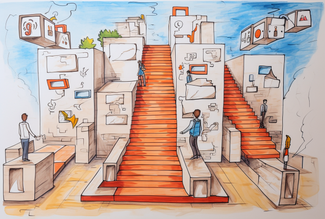
What is digital dexterity and why does it matter?
The working world is beginning to realize that our reliance on instant messaging isn’t contributing to our productivity. So now, the race is on to find solutions that work for getting work done. However, implementing these solutions company-wide comes with an essay-long list of challenges. Transitioning from one tool that promised connectivity to another is difficult. And it’s tough to be hopeful about a new tool when the first one never did what it promised to begin with.
Some businesses have managed a hybrid transition with only a few scrapes along the way. But remote and hybrid work also have a great way of illuminating bad leadership, shotty processes, and flimsy culture.
One of the defining differences between the companies that have succeeded in building a modern working model and those that haven’t is their degree of digital dexterity.
Most companies aren’t ready to respond to disruptions that call for meaningful digital change. One Capgemini report shows that less than half of organizations feel they have the right digital capabilities to see through successful transformations, a finding further enhanced by Gartner’s claim that only 9% of the overall workforce demonstrates strong digital dexterity.
But if the pandemic has proven one thing for companies, it’s that they must be ready to reorganize and pivot in response to market challenges as well as opportunities. The more digitally dexterous your organization is, the better prepared the workforce will be in facing a future where rapid adaptation to digital change is the norm and not the exception.
What is digital dexterity?
A digitally dexterous organization is alert to emerging technologies and digital solutions. They are agile, ready to shift strategy, and can achieve business outcomes in rapidly changing market conditions using these new technologies.
Now, that definition’s a little on the tech-heavy side. Here’s another one:
Digital dexterity is not a competency in itself, then, but rather, as Gartner has it: “A set of beliefs, mindsets, and behaviors that help ... deliver faster and more valuable outcomes from digital initiatives.”
What are the key skills people should have for an organization to be digitally adaptive? The essential quality of digitally dexterous employees is that they are adaptive. Being able to use, think about, and organize digital technologies in innovative and advantageous ways is great — but a genuinely adaptive employee is the one who adopts these solutions into their everyday routine.
How to measure digital dexterity of a company
According to Gartner, there are six indexes that suggest a company has digital dexterity.
- Consumerization – constantly changing work requiring judgment calls, what we would call a pivot.
- Team-based collaboration – effortless coordination that allows for routine collaboration.
- Nonroutine work – spending time on personal and professional growth. This could look like learning a new skill or tool, like how to pull data from different platforms, or adopting new technology to solve a specific problem that comes up in your daily work.
- Nondirected social engagement – putting effort into trusting and getting to know your team. Social engagement greatly impacts team collaboration, as well.
- Tech positive – a desire to solve problems with new technology, being willing to accept the changes a new tool brings to the organization.
- Work anywhere – The ability to work, well, anywhere.
For employees, the Griffith University Library created a self-assessment tool to analyze your skills with different aspects of digital dexterity and point you towards resources to learn more about what you need to improve upon.
How to develop digital dexterity in your organization
So how can an organization make itself more digitally dextrous today? Here are five steps that are essential to prioritize:
1. Bring autonomy into your teams
Autonomy is a contributing factor to employees' work engagement and satisfaction. But in the distributed-work context, autonomy can also result in disengagement if workers are consistently left to their own devices.
It’s crucial to encourage the freedom to be creative in any digital dexterity program through supported and structured opportunities. In other words, employees should have the freedom to explore and experiment while simultaneously being supported.
It’s this process of “collaborative autonomy” that can help define a company’s collective vision. But it also enables employees to understand both their individual and connected role in contributing to that vision. And because teams are aligned through shared goals and are aware of what they need to do and what others’ roles are too, they can deliver business value at a brisker pace.
Read more: Autonomy is the key to employee engagement
2. Diversity as a driver
Cross-pollination of teams from different areas, experience, function, and geography is crucial in constantly innovating new perspectives, filling in skills gaps, and updating skills.
Collaborating across teams in this way is also a key factor for quick and informed decision-making.
But diversity needs to be in all areas of the organization, from teams to onboarding support and learning tools.
In this latter area, it’s important to keep in mind that employees will differ in how they like learning and receiving information. Some may prefer slide-shares or videos, while others may process details better when verbally led through them step-by-step.
Ensuring that the company's digital adoption tools are in all formats is a not-to-be-forgotten part of the diversity process.
3. Failure is key
Companies that put all the focus on success are missing the learning opportunities of failure.
In environments where teams from different areas and experience levels regularly share information, those encouraged to communicate past mistakes and missteps to look for solution-based alternatives are quicker to adapt and innovate effective course corrections.
Examining failure helps organizations get real about existing digital practices and processes. But it also encourages the kind of confident, creative, and lateral thinking needed in the development of digital dexterity.
4. Shock and awe
Digital dexterity cannot be aced in the classroom. The best way for employees to understand how digital initiatives work across a company is through hands-on experience.
Dropbox said it best:
"Work from home is not merely office work transposed to a new location. It’s a new skill — a new human technology — that we’re learning in fits and starts. Like all technologies, first we emulate what came before."
The forced shift to work is perhaps the best example of your company showcasing its digital dexterity. Some companies adapted better than others, likely because of existing remote workers or technologies they had already adopted. Others had to adopt new technologies at the speed of light to keep up. For all of us, it was a shock and forced entire companies to think and act on their feet.
Exposing workers to the shock and awe of digital initiatives used in different areas of the organization encourages them to understand how different parts of the business connect and interact.
The more effortless this exposure is, the more likely employees are to engage with information and expertise across the organization. Doing so then enables them to develop key competencies needed for digital dexterity such as adaptability and willingness to learn. Another related spill-over is that by accruing accurate data and contacts, employees begin building resilience to risk, uncertainty, and setbacks — all valuable assets in today’s climate.
5. Take it to the top
Of course, employees are not the only key stakeholders in a company’s digital dexterity program. Ensuring senior managers understand the importance of digital dexterity and can scale in this area is vital.
To that end, they must lead by example, modeling digital dexterous behavior such as collaborative interaction and adaptability, and encouraging digitally-friendly workplace designs and processes.
That also means C-suite staff will need support in the form of resources, tools, and training.
Yet this kind of investment in an organization’s leadership has a powerful drip-down effect on the company. For not only will digitally dexterous senior staff be more inclined to advocate for the processes and operations needed to drive digital transformations, but Gartner finds that while only 16% of leaders are classed with high digital dexterity, employees of these leaders are 2.4 times more likely to share the same qualities.
Why digital dexterity matters
Digitally dexterous employees tend to use technology as a tool for competitive advantage. They look for solutions that are customer-centric and are in-step with advancing digital technologies.
Research shows companies that invest significantly in technology and adapt to fast-changing trends typically outperform competitors in critical areas such as innovation and customer satisfaction. However, according to new research from Qatalog, 34% say their employer has either not invested, or has not adequately invested, in the tools and policies needed to support remote or flexible work.
On the flip side, organizations that rely on legacy systems or old ways of working tend to find themselves falling behind to such an extent that their focus is fixed on catching up instead of charging onwards.
But investing in technology is only a good idea if employees are properly prepared and willing to adopt new digital practices. If they’re not, organizations are wasting their investment as well as the opportunity to help digital dexterity thrive.
For example, the scale and speed with which digital collaboration tools were deployed during the COVID-19 crisis didn’t automatically align with an equally high success rate in using these tools. Rather, companies’ mad dash to download as much remote-work tech as possible points to the fact that they were caught off-guard with the pandemic’s challenges.
This resulted not just in an uneven adoption of remote-work technologies, but inefficient use of them, too. For many employees working from home for the first time, the pressure to adapt quickly to new technology came without the supportive infrastructure to ensure their continuing well-being and productivity.
But it’s that infrastructure, which includes strategic and technical support, open communication across traditional boundaries, and nurturing greater autonomy alongside team-based ways of working, that’s at the core of digital dexterity.
Organizations that fostered those traits within 2020’s remote and distributed workplace shift most effectively managed the sudden shift to work-from-home operating models. They’re also the businesses best placed to optimize remote work as a strategic model in 2021. Why? Because they’ve already cultivated the conditions needed to produce organized, agile, and advantageous digital transformations.
The future of successful companies is digital dexterity
Digital dexterity has been and will continue to be the measurement that distinguishes successful businesses from those that fail. It’s not enough anymore for companies to be future-ready. The future’s already here. Thousands of teams trust Qatalog to connect and coordinate work across every part of their business. Find out more by booking a call with our Customer team.



